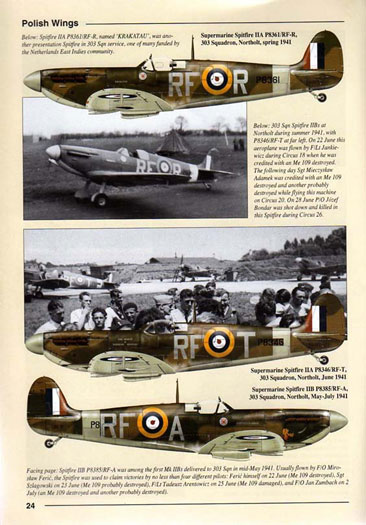|
S u m m a r y
|
| Catalogue Number: |
Polskie Skrzydla Nr. 6 -Polish Wings
No. 6
Supermarine Spitfire I/II
By: Wojtek Matusiak
Illustrated by Robert Grudzien |
| ISBN: |
978-83089450-55-5 |
| Media: |
Soft cover;
A4 format; 48 pages plus covers |
| Price: |
GBP £6.50 from Mushroom Model Publications
and
USD$20.66 from Squadron Mail Order |
| Review Type: |
First Read |
| Advantages: |
Color profiles of 31 individual aircraft.
English text |
| Disadvantages: |
|
| Recommendation: |
Highly Recommended |
Reviewed by
Steven "Modeldad" Eisenman

Polish
Wings 6 "Spitfire Mk.I/II"
is available online from Squadron
There is no need for a Polish-English dictionary to enjoy the latest in the
Polish Wings series of monographs. The switch to very readable English text and
captions could not have come at a better time, given the subject matter.
The author begins this volume with a discussion of the Polish government’s
effort to purchase Spitfires from the UK. Interestingly, he attempts to trace
the fate of the single Spitfire sent to Poland. If true, this refugee Spitfire
made its way back to the RAF in Egypt, after service in the Turkish Air Force.
The narrative then continues with a description of Poles serving in RAF
squadrons during the Battler of Britain. Polish pilots were assigned to
Spitfires during the height of the Battle, during the first week of August
1940.
 The
bulk of the monograph focuses on the specific Polish Air Force Squadrons that
operated the Spitfire Mk. I/II in combat. These squadrons were 303 Sq. ‘City of
Warsaw’ (RF), 308 Sq. ‘City of Cracow’ (ZF), 306 Sq. ‘City of Torun’ (UZ) and
315 sq. ‘Deblin’ (PK). While other Polish squadrons received the Mk. I/II
Spitfire, these were used in training, not operational roles. The
bulk of the monograph focuses on the specific Polish Air Force Squadrons that
operated the Spitfire Mk. I/II in combat. These squadrons were 303 Sq. ‘City of
Warsaw’ (RF), 308 Sq. ‘City of Cracow’ (ZF), 306 Sq. ‘City of Torun’ (UZ) and
315 sq. ‘Deblin’ (PK). While other Polish squadrons received the Mk. I/II
Spitfire, these were used in training, not operational roles.
The author also notes the use of the early Spitfires by Polish pilots in other
capacities. This includes Polish pilots serving in PRU’s OTU’s and Ferry
Flights.
Finally, if the author is correct, and it seems to be a long stretch on his
part, the first Spitfire that Polish pilots flew, as part of the Polish
government’s purchase commission, may have wound up as a German war trophy
displayed in Cracow, Poland in 1942.
As
in the prior monographs in the Polish Wings series, the profiles are well
integrated with photographs of the actual aircraft. The photographs also receive
detailed captions, a lot more than just serial number and squadron.
As
for the profiles themselves, they are as good as, or perhaps even better than,
those in the previous volumes. What the artist has captured quite well is the
transition from the Temperate Land Scheme of Dark Green, Dark Earth and Sky to
the Day Fighter Scheme of Dark Green, Ocean Gray and Medium Sea Grey. Although
I cannot attest to the accuracy, the artist has presented profiles showing
Temperate Land Scheme aircraft over painted in Day Fighter Scheme colors.
After finishing this excellent work, what struck me most was the statement by
the author that: “A total of at least 1,500 Spitfires were officially allocated
to Polish units (and paid for by the Polish Government), making the Polish AF
the largest ever Spitfire operator outside the RAF, and also making the Spitfire
the most numerous aircraft type in the history of Polish military aviation.” A
concept maybe hard to understand in that the Polish Air Force Spitfires usually
wore RAF roundels.
This is an excellent addition to the Polish Wings series, and would be enjoyed
by anyone interested in Spitfires or the role of Polish pilots in the early
years of the War. Highly recommended
All Mushroom Model
Publications books are
available direct from the publishers,
who now accept credit cards (Visa, MC, Amex, Switch)
Thanks to
Roger at Mushroom Model Magazine for
the sample.
Review Copyright © 2007 by Steven "Modeldad" Eisenman
This Page Created on 18 March, 2007
Last updated 24 December, 2007
Back to HyperScale Main Page
Back to Reviews Page
|
Home
| What's New |
Features |
Gallery |
Reviews |
Reference |
Forum |